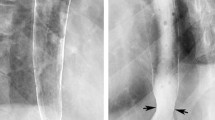Abstract
This study was undertaken to determine the prevalence of vascular compression in manometric tracings and to determine whether these findings had any clinical significance. Vascular compression, defined as a localized area of elevated intraesophageal resting pressure >4 mm Hg with superimposed cyclic pressure spikes with a frequency of 60–100/min, was noted in 55 of 241 consecutive tracings. The groups with and without vascular compression were similar with regard to mean age, sex, and prevalence of dysphagia. Radiographs were available for 29 of the 55 and showed compression in 18, but there was no relationship with the manometric findings, except for a trend towards finding a positive esophagogram with amplitudes >16 mm Hg. Eleven tracings showed absent “relaxation” of this elevation of pressure in response to swallows, and five of six available esophagograms showed a corresponding area of compression. We conclude that manometric evidence of vascular compression is common and generally has no clear relationship with esophagographic findings or dysphagia. However, the combined findings of marked increases in pressure and absence of relaxation in response to swallows may indicate evidence for a vascular cause of dysphagia.
Similar content being viewed by others
References
Mittal RK, Siskind BN, Hongo M, Flye MW, McCallum RW: Dysphagia aortica: Clinical, radiological and manometric findings. Dig Dis Sci 31:379–384, 1986
Berenzweig H, Baue AE, McCallum RW: Dysphagia lusoria. Report of a case and review of the diagnostic and surgical approach. Dig Dis Sci 25:630–636, 1980
McNally DO, Rak KM: Dysphagia lusoria caused by persistent right aortic arch with aberrant left subclavian artery and diverticulum of Kommerell. Dig Dis Sci 37:144–149, 1992
Dantas RO, deGodoy RA, Meneghelli UG, deOliveira RB, Troncon LEA: Dysphagia lusoria and segmental aperistalsis in the upper third of the esophagus. J Clin Gastroenterol 7:522–524, 1985
Cappell MS: Manometric findings in dysphagia secondary to left atrial dilatation. Dig Dis Sci 36:693–698, 1991
Traube M, McCallum RW: Comparison of esophageal manometric characteristics in asymptomatic subjects and symptomatic patients with high-amplitude esophageal peristaltic contractions. Am J Gastroenterol 82:831–835, 1987
Traube M, McCallum RW: Primary oesophageal motility disorders. Drugs 30:66–77, 1985
Author information
Authors and Affiliations
Rights and permissions
About this article
Cite this article
Stagias, J.G., Ciarolla, D., Campo, S. et al. Vascular compression of the esophagus: A manometric and radiologic study. Digest Dis Sci 39, 782–786 (1994). https://doi.org/10.1007/BF02087424
Received:
Revised:
Accepted:
Issue Date:
DOI: https://doi.org/10.1007/BF02087424




